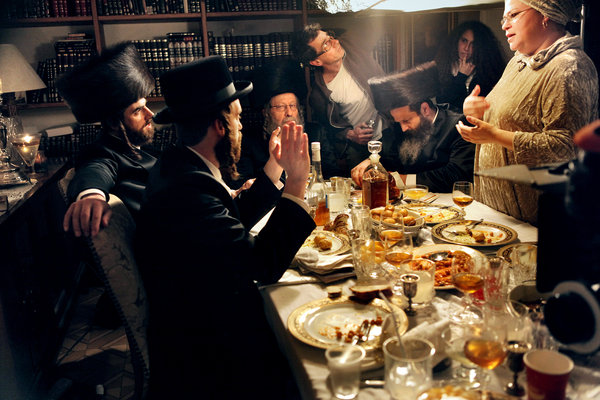
Rama Burshtein, the Israeli director of “Fill the Void,” at right on the film set. (Photo: Vered Adir/Sony Picture Classics)
Some art forms favor expansion. Those are the ones that ask—require?—you to untether yourself and be taken outward, into a nimbus that exists beyond the quotidian of terrestrial constraints. The epic experience in art is a call of surrender to an expansive, visionary, fully immersive adventure.
That’s what is asked for by Richard Wagner‘s music, David Foster Wallace novels, James Turrell‘s Roden Crater, Matthew Barney‘s Cremaster Cycle. And of course many theater productions like Robert Wilson‘s Einstein on the Beach, Richard Foreman‘s Ontological-Hysteric Theater, or a marathon viewing of Tom Stoppard‘s trilogy, The Coast of Utopia.
The counterpoint to the “epic out” is the “epic in”—work that brings us into a beautifully crafted universe where the mystery is in miniature, detailed and often a bit arcane. The Book of Kells comes to mind. Persian miniatures. Ann Carson‘s Vox. Many of the compositions by Terry Riley and Steve Reich.
I want both of these artistic directionals in my life. A culture that leans too heavily into one or the other is out of balance. Too much expansiveness results in a loss of nuance and delicacy. Too much of the intimate can constrict with its claustrophobia.
Cinema leans heavily toward the former, so films that take the counter stance and do it well are particularly inspiring. Rama Burshtein‘s Fill the Void is set in a tightly knit ultra-Orthodox community in Tel Aviv. Almost all of the film takes place indoors, the cinematography lushly detailed and evocate, Vuillard-esque in its jeweled beauty. Because Burshtein is a member of the community, her telling of this variation on the marriage plot theme has a tender intimacy even though the social mores of this community are as foreign to our contemporary values as a Margaret Mead South Seas exposé. Their world is small and isolated from everything outside (at one point in the film the sound of a Purim celebration on the street below is quelled by closing the open window) but Burshtein takes us through the keyhole and into a richly textured, emotionally fine tuned, deeply authentic portrait of life.
I know something about communities that isolate themselves and preserve their heritage in a culture within a culture bubble. Survival for these groups requires vigilance, so most of the stories involving cloistered groups focus on boundary skirmishes and the primal “are you in or are you out?” issues. Refreshingly that is not Burshtein’s focus at all. Rather she immerses you completely in a world where support for all the members is unquestioned. One of the women in the community who has no arms is fed effortlessly by her sister. Another woman wants to purchase a stove and interrupts a rabbinical council to ask for help. When the rabbi discovers she has no family to assist her in that decision, he stops the proceedings to advise her. The compassion is so simply stated, and so extraordinary. That small action offers up a window into the bigger meaning.
The power of the small. This is an exquisite example and an unforgettable film.
Part 2, coming soon: Working both ends, the epic out and the epic in. Matthew Barney‘s show of (mostly) drawings at the Morgan Library, Subliming Vessel, offers an extraordinary counterpoint to his large scale undertakings.
What a splendidly evocative review
A, I do think it is a film you would find fascinating. Thanks for your comment.
Beautifully written, Deborah.
What a pleasure to read your very evocative review! Must see this film!
I will look forward to hearing your response Diane.
Thanks Maureen.
Epic out and epic in – I love your descriptors. Other artwork comes to mind, like Rothko ‘s paintings. When you confront them physically, they really take you “out.” A lot of color field painting does this, too. Interestingly, “epic in” artwork does not cause contraction of the spirit as one might expect. Somehow, focusing on the tiny is another way to expand the mind.